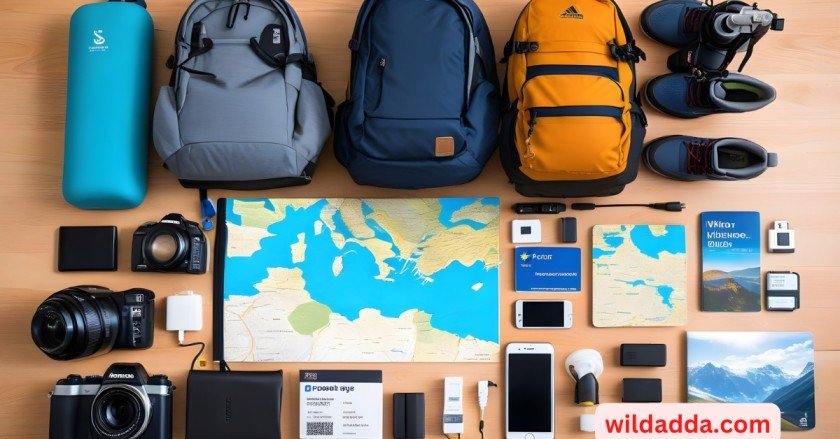Introduction for Winter in Europe
When traveling through Europe for 3 weeks in the winter, packing the right clothes and gear is essential to staying warm and comfortable on your adventures. Though preparing for an extended multi-country winter vacation seems daunting, following some key tips will ensure you have everything you need. Trip to Europe
The main strategy should focus on versatile layers and wardrobe essentials you can mix-and-match for different situations for trip to Europe. Knowing how to effectively organize and streamline your luggage is also key. By preparing for colder temperatures, researching your destination weather averages, and rolling clothes to optimize space, you’ll be set up for success backpack through Europe even in the winter months.

Prepare for Cold Weather
The average December through February high temperatures across most central/northern European destinations range from 35-45°F, with averages lows falling between 25-35°F. When combined with snow and wind, the felt temperature can often feel significantly colder during European winters. It is better to overprepare with warm gear you can adjust, than underpack and suffer the consequences of being cold.
Research the specific cities on your itinerary to adjust for anomalies, but when figuring out what to pack for 3 weeks in Europe during winter, your suitcase space should focus primarily on insulation layers and cold weather gear. This includes thick sweaters, winter coats, durable snow boots, gloves, hats, and scarves. Trip to Europe
Having 2-3 base insulating layers and both a medium weight winter jacket plus an ultra-warm parka style coat provides flexibility across temperatures. Choose outerwear coats that are waterproof or opt for separate water-resistant shell layer.
Choose Layers and Warm Accessories for Trip to Europe
The key to survival as you backpack through Europe in winter is dressing in adaptable warm layers that you can mix-and-match. As you transition between indoors and outdoors, across locations, and in fluctuating temperatures, adjustable layered outfits are essential.
For your bottom half, pack a pair of lined waterproof pants and water-resistant winter hiking boots. Combine with tall wool socks, and long underwear or fleece-lined leggings you can layer underneath pants as needed.
For your top half, bring multiple long sleeve wool thermal tops, wool sweaters, a fleece jacket, and insulated winter vest to mix-and-match over your t-shirts. Round out your layered outfits with wool scarves, fleece-lined beanies, and thick insulated gloves.

Pack Versatile, Mix-and-Match Outfits
The bulk of your winter Europe packing list should focus on versatile pieces you can repeat across multiple outfits. The key categories to strategize are:
Tops – Fleeces, sweaters, thermals
Bottoms – Jeans, hiking pants, leggings
Outer Layers – Winter coats and snow jacket
Hand & Head Coverings – Hats, gloves, scarves
Choose neutral colors across categories and aim for breathable synthetic blends that will retain warmth even when damp. Having multiples of critical warm layers allows you to alternate as some pieces dry if they get wet during outdoor winter activities.
Make sure to keep at least one outfit separate for transit days in case bags get delayed too. Roll all clothes tightly and utilize organizational packing cubes to optimize space and keep sorted as you hop destinations.
Organize Toiletries and Medications
In addition to apparel and gear, organizing your luggage to keep essential winter care items easily accessible is key for health and comfort.
Be sure to pack chapstick, lotion, a humidifier, and sinus rinse kits to combat dry winter air. Bring any vital medications, multivitamins, pain/upset stomach relievers, and medical documentation in your carry-on bag.
If you’ll have laundry access just once per week, pack enough socks, underwear, and base layers to last between wash cycles. You may want to consider bring 1-2 wash packs as backup too.
Miscellaneous Essentials
A few final miscellaneous items that are essential when packing for an extended winter trip to Europe include:

- Winter-specific backpack/suitcase
- Portable phone charger/power bank
- Eye mask & ear plugs
- Camera, SD cards, extra batteries
- Collapsible water bottle
- Passport, ID, travel documents
- Insurance cards & travel insurance info
- Guidebooks/maps/translators
- Snacks
By utilizing packing organizers, personal item bags, and smart rolling techniques – you can prepare everything on this 3 week winter trip to Europe packing list within a single checked bag and carry on. Just focus on warm versatile layers, prepare for colder temps, and research your destinations. With a well planned Europe winter packing strategy, you’re ready to comfortably explore spectacular seasonal destinations.
FAQS
FAQ #1: How many coats and jackets should I pack for 3 weeks in Europe during winter weather?
Since temperatures and weather conditions can vary significantly across different regions in Europe, it’s best to come prepared with versatile layers and multiple winter coat options when packing for 3 weeks. At minimum, bring one medium-weight insulated winter jacket like a parka or puffer that is water and wind resistant. Also pack an ultra-warm outer shell, preferably with a removable fleece liner, to handle more extreme cold and snowy conditions for activities like skiing or winter hiking. A bonus third layer could be a waterproof hard shell jacket.
FAQ #2: What are the best shoes to wear when walking around European cities in winter?
While sightseeing through Europe for multiple weeks in winter, the optimal footwear is a pair of warm, waterproof winter hiking boots or snow boots with good traction. These will keep your feet dry, provide ankle support on slick surfaces, and maintain warmth during long days of exploration. Bring a couple pairs of moisture wicking wool socks as well to keep your feet comfortable. Make sure to break in the snow boots ahead of time so they don’t cause blisters. If packing space is tight, waterproof hiking shoes paired with or tall waterproof boots can also work.
FAQ #3: What winter accessories are most vital to pack for hands, ears and head? You’ll want to devote some packing space for winter accessories like hats, gloves and scarves to protect from more exposed areas of cold. Must-have accessories for winter trips less than one month long include: wool beanie hat, thick insulated gloves with grip, glove liners, and a cashmere or wool-silk blend wrap scarf. If doing any skiing or extended outdoor winter adventures also pack a balaclava face mask and upgraded ski gloves. Hand warmers and foot warmers are also great as backups when temperatures really plummet.
FAQ #4: How many thermo and base layers should I pack for a 3 week winter trip? A good rule of thumb when considering thermo layers, fleece tops, leggings and base layers for a winter trip lasting over 2 weeks is:
- Long sleeve wool or synthetic thermal shirts (2-3)
- Fleece sweaters and pullovers (2-3)
- Breathable long underwear bottoms/leggings (2-3)
Bringing multiples allows you to alternate between wears and switch out any layers that get too damp from sweat or weather. Having options you can mix and match also means you can adjust comfort levels across a range of temperatures and conditions during winter.
FAQ #5: What medications, toiletries or specialty gear should I include for staying healthy in winter?
To counter being outside in the harsh drying elements associated with cold weather for an extended time, make sure to pack lotions, lip balms and facial moisturizers. Bring any eyecare products you use regularly as well. Having a humidifier for hotel rooms, anti-inflammatory creams, and nasal hydration/sinus rinse products can all help mitigate issues in winter too. OTC meds like decongestants, upset stomach relievers and vitamins are also a good safety buffer for long trips. Staying generally healthy is vital when exploring new places in winter, so preparation is key.
